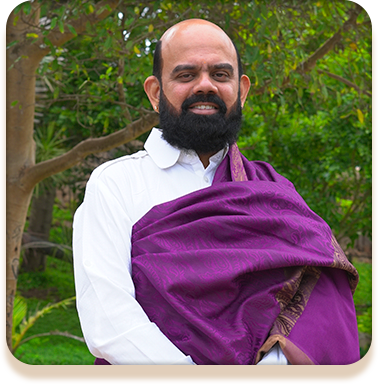Sathya Kalyanasundaram, fondly addressed as Sathya-ji or G by his students was, from a
young age drawn to the concept of spirituality. He had numerous questions of his father,
who was (& still is) a staunch follower of the Sanatana Dharmic way of life. In addition to
being a highly successful financial auditor, Sathya-ji’s father was instrumental in sowing the
seeds of devotion across family, friends and anyone else he came in contact with. the
house always reverberated with Satsangs, bhajans and other devotional activities which
culminated in acts of charity as well.
Growing up in this environment, Sathya-ji was highly curious about the various rituals, their
meanings, the aspect of daily practice and Bhakti (devotion). After completing his collegiate
studies in Chennai, he proceeded to obtain a MBA from the US and also a CPA (equivalent
of the CA). Sathya-ji felt a deep connection to return back to India, and did so after working
in the USA for over 10 years. He continued his corporate life taking leading roles at Texas
Instruments & Scientific Games as their CFO and eventually becoming a CEO to lead
multinational companies such as MobME, Experian and Eureka.
Throughout this time, he was enquiring of his faith and his spiritual journey – he spoke
regularly to his father’s friends, spiritual teachers and Yoga educators about a constant
yearning that existed in pursuing a spiritual path. During the Covid pandemic, he made the
decision to quit his successful corporate career and take care of his parents, who were
briefly ailing due to the overall conditions that existed across the world. During this time and
in a chance meeting with his family priest, he continued the discussions on spirituality and
determined to begin a daily practice (sadhana) At the same time, he was introduced to the
Krishnamacharya Yoga Mandiram (KYM) by his close friend and classmate from school –
Sathya-ji decided to enrol for the KYM teacher training program.
Having begun the dual journey of a personal practice and a Yoga Teacher Training program,
Sathya-ji spent the next two years focusing all his energies and time to learn the nuances of
the yoga journey, which closely coincided with his personal practice. The various aspects of
evolution, the facets of Yoga – Raja Yoga, Kriya Yoga, Ashtanga, personal practice of
asana, pranayama and dhyana, were all imparted by his illustrious teachers at KYM.
By the time, Sathya-ji was midway through the course, he was clear that teaching Yoga was
his ultimate calling. He was profoundly impacted by the Yoga Sutra of Sage Patanjali, which
a monumental treatise in explaining the concept of evolution, birth, death, happiness &
elimination of sadness, the health of the body, breath as the ultimate force of life, and the
means to achieve self-realization.
Sathya-ji was intricately guided by his guru and mentor, Sri V Srinivasan (VS Sir) of the
KYM, to structure his approach, his studies and his practice, in a manner that would
ultimately serve him in his teaching. VS Sir also guided Sathya-ji to introspect into each
action and individual that he came across & cultivated the approach to “learn from everything
and from everyone”.
Since his graduation from the teacher training program, Sathya-ji has spent his time
structuring the path of Ananta – the yoga Academy he founded. Ananta is an offering of devotion to all the Yoga gurus beginning from Sage Patanjali to Sri T Krishnamacharya, who paved the path for millions to learn, teach and experience Yoga as a way of life, and means to self-realization.
Sathya-ji is deeply committed to teaching Yoga in the lineage of Sri T Krishnamacharya, who
was the first to link body breath and movement, now famously known as Vinyasa Krama.
Sathya-ji’s fundamental philosophy is to help students & practitioners understand that Yoga
is the best practice to heal & strengthen the body, mind and soul – paving the way for self-
realization.
As part of his own yoga journey, Sathya-ji is now focused on learning and further
understanding the intricate aspects of Yoga philosophy – delving deeper into the concepts of
evolution, the relationships between the Purusa & Prakriti, understanding the tri-gunas,
Karma, the concepts of Avidya & Ahamkara (to name a few) – thus providing greater insight
to practitioners on the detailed means to eradicate sickness and unhappiness – and to help
all achieve a state of balance, acceptance, health and overall bliss.

